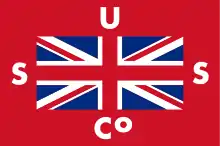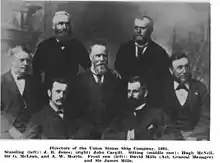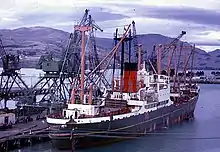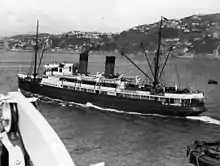Union Company
Union Steam Ship Company of New Zealand Limited was once the biggest shipping line in the southern hemisphere and New Zealand's largest private-sector employer. It was incorporated by James Mills in Dunedin in 1875 with the backing of a Scottish shipbuilder, Peter Denny.[1] Bought by shipping giant P&O around the time of World War I it was sold in 1972 to an Australasian consortium and closed at the end of the twentieth century.
 | |
| Industry | Shipping, freight and passenger services |
|---|---|
| Founded | 1875 |
| Founder | James Mills |
| Defunct | 2000 |
| Headquarters | Dunedin (1875–1921) , Wellington New Zealand |
.jpg.webp)

.jpg.webp)
James Mills
James Mills had worked for Johnny Jones and his Harbour Steam Company. After Jones’ death in 1869 Mills tried twice to float a Union Steam Ship Company of New Zealand Limited without attracting enough interest from local investors but in 1875 he found backing from Scottish shipbuilder Peter Denny in return for Union Steam Ship orders for Denny's Dumbarton shipyard. The Denny-built Hawea and Taupo, both then large by local standards, arrived in mid 1875 and entered service. Union Steam Ship took over the Harbour Steam Company's vessels on 1 July 1875.[2]
Local competition
Union Steam Ship became a major shipping line dubbed "The Southern Octopus" with a near-monopoly on trans-Tasman shipping.[1] It steadily mopped up trans-Tasman and coastal shipping businesses including Anchor, Canterbury Steam, Richardson & Co and Holm.
Trans-Tasman
From 1889 there was three-way competition between Union Steam Ship, Huddart Parker and Tasmanian Steam Navigation Company (TSNCo) on the Tasmanian routes (Melbourne – Launceston, Hobart – Melbourne and Hobart – Sydney). TSNCo did not have other routes to absorb their Tasmanian losses and was bought out by USSCo in 1891. The rivalry between USSCo and Huddart Parker lasted to 1895 despite an earlier agreement in 1893. There was undercutting of fares and there were steamers shadowing each other from port to port. USSCo's Rotomahana and Mararoa would sail alongside the Miowra and Warrimoo, with other ships like the Te Anau and Manapouri sailing before and after and bracketing the Huddart Parker ships. The 1895 agreement between the two lines pooled the Auckland-Sydney profits and losses; the Melbourne-Launceston profits were divided 4/7 to USSCo and 3/7 to Huddart Parker. The Sydney-Hobart passenger trade was excluded but the cargo and stock trade was divided 2/3 to USSCo and 1/3 to Huddart Parker.[3] Mark Twain criticised travel conditions on a Union Company ship in 1897 in his travel book Following the Equator.
Mills was a UK resident after 1907 and died in London in 1936. By 1914 Union Steam Ship had 75 ships. It was the biggest shipping line in the southern hemisphere and New Zealand's largest private-sector employer.[1]

P&O
In 1917 P&O shareholders were asked to confirm their directors' prior purchase of Union Steam Ship with the information that USSCo had a valuable coasting trade within New Zealand, connections with India and Australia and a line of steamers running between Australia, New Zealand and Canada. The Union Steam Ship fleet was described as 74 high class steamers with a tonnage of 237,860 and of an average age of 12 years.[4][5] In November 1920, rumours surfaced that the head office of the company would shift from Dunedin to Wellington.[6] At the end of 1920, it became known that the board of directors would remain in Dunedin, but that all headquarters staff would transfer to Wellington.[7] The move happened in late 1921, with all head office functions in Wellington after the New Year holidays. About 70 staff transferred to Wellington, ending 46 years of Dunedin as the company's headquarters.[8]
Norrie Falla
With the Dunedin staff came Norrie Falla as general traffic manager. He had joined as a boy in Westport in 1898 and finished his accountancy exams in 1906. In 1910 he was put in charge of the cargoes and movements of Union's 65-strong fleet. Falla volunteered immediately for service in the 1914—1918 first world war. He was promoted to lieutenant colonel in 1916 and returned to his former post in 1919. He succeeded David Aiken as general manager in March 1934 and was appointed chairman in January 1936 on the death of founder Sir James Mills.[9]
Falla ordered two new passenger ships and began a steady renewal of cargo ships commissioning 11 ships between 1935 and 1939.[9]
Falla also took Union Company into airlines. First in 1934 into East Coast Airways and then Cook Strait Airways in 1935.[9]
Australian National Airways ANA
Union in conjunction with Holyman's Airways and Huddart Parker set up an airline across Bass Strait which began business in September 1934. In 1935 they added Adelaide Steamship Company as a partner in the venture which was renamed Australian National Airways the following year.[9]
Union took up a 20% interest on the formation of Australian National Airways in 1936.[9]
Union Airways NAC
In 1935 Union Airways of New Zealand was formed by Union Steam Ship and it built an air service through New Zealand. Union Airways was nationalised by the government in 1947 and renamed National Airways Corporation.[9] Union Travel remained a substantial operation as travel agents and tour operators.
Tasman Empire Airways TEAL Air New Zealand
Union was instrumental in establishing this business in particular by buying the first three flying boats which began operations in April 1940. TEAL became Air New Zealand.[9]
Falla dies
During World War II, Falla returned to the army with the rank of brigadier. He was later based in London as New Zealand representative on the Ministry of War Transport. He joined the main board of P&O in 1944. On his way back to New Zealand aged 62 he suffered a cerebral haemorrhage and died at sea 6 November 1945.[9]
P&O sell to TNT
Australian road transport business, Thomas Nationwide Transport, had a substantial road transport stake in New Zealand. With New Zealand investors TNT bought USSCo from P&O in 1971.[10][11][12]
In 1990 Union Steam Ship operated seven ships, and was involved in ship management, tourism, real estate and other ventures. By 2000, the Union Bulk[13] barge made its last voyage.[14]
Brierley Investments
At the end of the 20th century Brierley Investments bought all the shares, broke Union Steam Ship into components and sold up what it could.
Union Steam Ship Company of New Zealand owned more than 350 ships and has been the subject of a number of books.
.jpg.webp)
Ferries
Steamer Express Wellington to Lyttelton
Union Steam Ship began regular sailings between Wellington and Lyttelton in 1895 with the Penguin making two round trips a week. In 1905 this became a daily service year round. In 1933 the name "Steamer Express" was adopted for the service.[15] Over the years a number of ships were used, including two Maoris, two Wahines, two Rangatiras, and a Hinemoa.[16]
TEV Wahine entered service in October 1966 and foundered and sank at the mouth of Wellington Harbour 18 months later in April 1968. The TEV Rangatira entered service in 1972 and was withdrawn in 1976, bringing the Wellington–Lyttelton "Steamer Express" to an end.[15]

Wellington to Picton
In what has been described as "a fatal mistake",[17] the Union Steam Ship announced in 1956 that the Tamahine was to be withdrawn from the Wellington-Picton route in 1962 and unlikely to be replaced (despite an offer of a $3 million government loan).[18] The designer of the replacement ferry the GMV Aramoana recalled that, "The media said the whole thing was a red herring", adding, "In their view, if the Union Steam Ship Company couldn't make the service pay, Railways definitely couldn't."[19]
Fleet
| Name | Built | In service | Gross tonnage | Notes |
|---|---|---|---|---|
| SS Aorangi (1883) | 1883 | 1883–1915 | 4,163 GT | Sunk 10 August 1915 at Scapa Flow |
| MV Aorangi (1924) | 1924 | 1924–1953 | 17,491 GT | Arrived 25 July 1953 at Clydeside for breaking up |
| TSS Arahura | 1905 | 1905–1926 | 1,607 GT | |
| MV Hauraki | 1921 | 1921–1942 | 7,112 GT | Captured on 12 July 1942 by Imperial Japanese navy off the coast of Sri Lanka. IJN renamed it Hoki Maru and used the vessel until sunk in Operation Hailstone in Truk Lagoon |
| SS Hauroto | 1882 | 1882–1915 | 1,988 GT | Missing off the China sea after acquisition by Hauroto Steamship Co. Ltd., Hong Kong |
| TEV Hinemoa | 1946 | 1947–1967 | 6,911 GT | |
| SS Maheno | 1905 | 1905–1935 | 5,323 GT | |
| TSS Maori | 1906 | 1907–1946 | 3,399 GT | |
| TEV Maori | 1952 | 1953–1972 | 8,303 GT | |
| SS Marama | 1907 | 1907–1937 | 6,437 GT | |
| SS Makura | 1908 | 1908–1937 | 8,075 GT | Arrived 8 April 1937 at Shanghai for breaking up |
| SS Manapouri | 1882 | 1882–1915 | 1,783 GT | First to have electric lights[20] Sunk 1945.[21] |
| TSS Maunganui | 1911 | 1911–1957 | 7,527 GT | Sold 1948 as SS Cyrenia; arrived 1957 at Savona for breaking up |
| SS Monowai | 1925 | 1925–1960 | 10,852 GT | Ex-SS Razmak (1925–1930); sold 1960 in Hong Kong for breaking up |
| SS Ohau | 1885 | 1885–1899 | 411 GT | She and sister ship, Taupo, were built by William Denny & Brothers.[22] The Ohau arrived on 14 January 1885[23] and Taupo on 10 March 1885.[24] Ohau sank whilst carrying timber and coal. She was supposed foundered in a heavy gale. Last seen off Cape Campbell on 12 May 1899. Some wreckage was found near Castlepoint. Lost with all 22 crew.[25] An inquiry into the loss dismissed claims that the ship was too low in the water.[26] A council-published heritage trail says locals still find coal on the shore near Cape Campbell, likely from the Ohau.[27] |
| SS Penguin | 1864 | 1879–1909 | 874 GT | Sunk 12 February 1909 off Cape Terawhiti; 75 deaths |
| TEV Rangatira | 1930 | 1931–1965 | 6,152 GT | |
| TEV Rangatira | 1971 | 1972–1976 | 9,387 GT | |
| SS Rotomahana | 1879 | 1879–1921 | 1,727 GT | The name was used by at least two other ships of the era. The first mild steel ship in the Union fleet.[28] Built by William Denny & Brothers. Scrapped in 1926.[29] |
| RMS Tahiti | 1904 | 1904–1930 | 5,323 GT | Ex-RMS Port Kingston (1904–1911); sunk 12 August 1930 off Rarotonga; no death |
| SS Tararua | 1864 | 1864–1881 | 563 GT | Sunk 29 April 1881 off Waipapa Point; 131 deaths |
| TSS Wahine | 1912 | 1913–1951 | 4,436 GT | Ran aground on the Masela Island Reef off Cape Palsu in the Arafura Sea |
| TEV Wahine | 1966 | 1966–1968 | 8,948 GT | Sunk 10 April 1968 after hitting Barrett Reef during an extra-tropical cyclone; 53 deaths. |
| SS Waihora | 1882 | 1882–1903 | 2,003 GT | |
| SS Waihora | 1907 | 1907–1927 | 4,638 GT | |
| SS Waipori | 1901 | 1901-1928 | 1,976 GT | Later renamed Tung Lee in 1937. Scuttled in Yangtse River at Chinkiang in 1937 as blockship by Chinese Government during Japanese attacks.[30] |
| SS Wairarapa | 1882 | 1882–1894 | 1,786 GT | Sunk 29 October 1894 off Great Barrier Island; 140 deaths |
| SS Warrimoo | 1901 | 1901–1914 | 3,326 GT | |
| SS Whangape (1900)[31] | 1900 | 1900–1928 | 2,931 GT | Sister ship to SS Mont-Blanc (1899)[32][33] |
See also
- Union Airways of New Zealand — Union Line's airline subsidiary
Notes
- McLean, Gavin (20 November 2013). "Mills, James". Te Ara – the Encyclopedia of New Zealand.
- "Telegraphic News". New Zealand Times. 30 June 1875. p. 2 – via Papers Past.
- McLean 1990, pp. 49–66.
- Company Meetings The Times 28 June 1917 page 11
- "The shipping fusion". Evening Star. No. 16462. 28 June 1917. p. 6. Retrieved 16 June 2021.
- "The Union Company". Mataura Ensign. 13 November 1920. p. 3. Retrieved 16 June 2021.
- "Untitled". Otago Daily Times. No. 18120. 16 December 1920. p. 4. Retrieved 16 June 2021.
- "Shifting headquarters". Evening Star. No. 17822. 19 November 1921. p. 2. Retrieved 16 June 2021.
- Norris Stephen Falla Te Ara Encyclopedia of New Zealand
- Bids Deals and Mergers The Times 5 September 1970 page 16
- New company formed to run Tasman services Freight & Container Transportation December 1971 page 4
- Sale of Union SS Co Australian Transport January 1972 page 35
- "New Zealand Maritime Index". www.nzmaritimeindex.org.nz. NZNMM. Archived from the original on 12 April 2016. Retrieved 29 March 2016.
- "Union Steam Ship Company flag". New Zealand history. Retrieved 29 March 2016.
- "Steamer Express". New Zealand Coastal Shipping. Retrieved 8 February 2015.
- McLean, Gavin (13 July 2012). "Page 6. The Union Company expands". Te Ara – the Encyclopedia of New Zealand.
- McLean, Gavin (2009). A Voice for Shipping (PDF). New Zealand Shipping Federation Inc. p. 60. ISBN 978-1-877448-76-8.
- "New Zealand's Cook Strait Rail Ferries". The New Zealand Maritime Record. Retrieved 29 March 2016.
- "Cook-Strait ferries changed the nature of shipping in New Zealand" (PDF). The Marlborough Express. 13 August 2012.
- "Red and Black". Auckland Star. 14 October 1933. Retrieved 23 August 2020 – via Papers Past.
- "Manapouri 1882–1915". New Zealand Ship and Marine Society. Retrieved 23 August 2020.
- "New Boats for the Union Company. EVENING POST". paperspast.natlib.govt.nz. 6 January 1885. Retrieved 21 May 2021.
- "SHIPPING. EVENING STAR". paperspast.natlib.govt.nz. 14 January 1885. Retrieved 21 May 2021.
- "TELEGRAMS. EVENING POST". paperspast.natlib.govt.nz. 11 March 1885. Retrieved 21 May 2021.
- "Return of Wrecks and Casualties to Shipping reported to the Marine Department from the 1st April, 1899, to the 31st March, 1900". Retrieved 17 June 2021 – via natlib.govt.nz.
- "INQUIRY INTO THE LOSS OF THE S.S. OHAU. COLONIST". paperspast.natlib.govt.nz. 29 June 1899. Retrieved 21 May 2021.
- "Marlborough Heritage Trails". www.arcgis.com. Retrieved 21 May 2021.
- "Old steamer doomed". New Zealand Herald. 12 April 1928. Retrieved 23 August 2020 – via Papers Past.
- "Steamer Rotomahana". Auckland Star. 12 May 1926. Retrieved 23 August 2020 – via Papers Past.
- "Tung Lee SS". Wrecksite.
- "Steamers & Motorships". Lloyd's Register of Shipping (PDF). Vol. II. Lloyd's Register Foundation. 1933. Retrieved 15 June 2019.
- Amended Plan of the Midship Section of a Steel Screw Steamer Mont Blanc, Lloyd's Register Foundation, 6 May 1898, retrieved 15 June 2019
- Engine and Boiler Arrangement for Mont Blanc, Lloyd's Register Foundation, 6 May 1898, retrieved 24 June 2019
Bibliography
- Farquhar, Ian (2001). Union Fleet. Wellingotn: New Zealand Ship & Marine Society. ISBN 0959783474.
- McGregor, Rae (2009). Sailing to Success: The Union Company Cadet Scheme. Wellington: New Zealand Ship & Marine Society on behalf of Union Company Cadets Reunion Committee. ISBN 9780473152178.
- McLean, Gavin (1989). Ships of the Union Company. Wellington, NZ: GP Government Print. ISBN 0-477-00016-9.
- McLean, Gavin (1990). The Southern Octopus. Wellington, NZ: New Zealand Ship and Marine Society & Wellington Maritime Museum. ISBN 0959783431.
- McLauchlan, Gordon (1987). The Line that Dared: A history of the Union Steam Ship Company 1875–1975. Auckland: Four Star Books. ISBN 0-9597853-0-2.
External links
- Grace, Michael L (10 September 2009). "The TEV Wahine Disaster and the Union Steamship Company of New Zealand". Cruise Ship History.
- McLean, Gavin. "Union Steam Ship Company". New Zealand Ship & Marine Society.
- McLintock, AH, ed. (1966). "The Union Steam Ship Co.". An Encyclopaedia of New Zealand. RE Owen, Government Printer.
- "Lyttelton-Wellington ferries". New Zealand History.
- "Page 6. The Union Company Expands". Te Ara, the Encyclopaedia of New Zealand.
